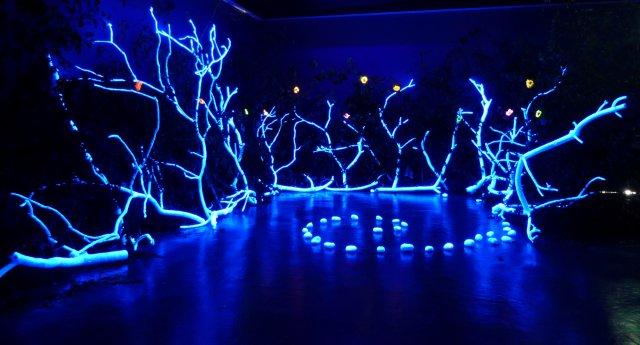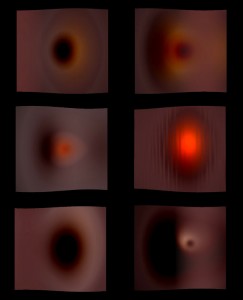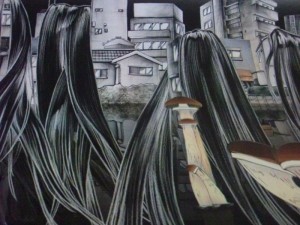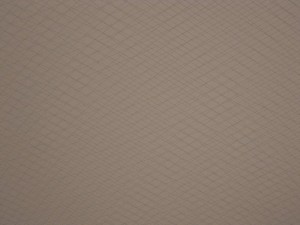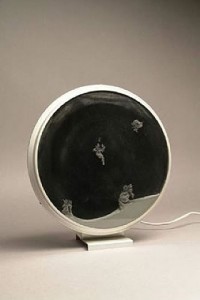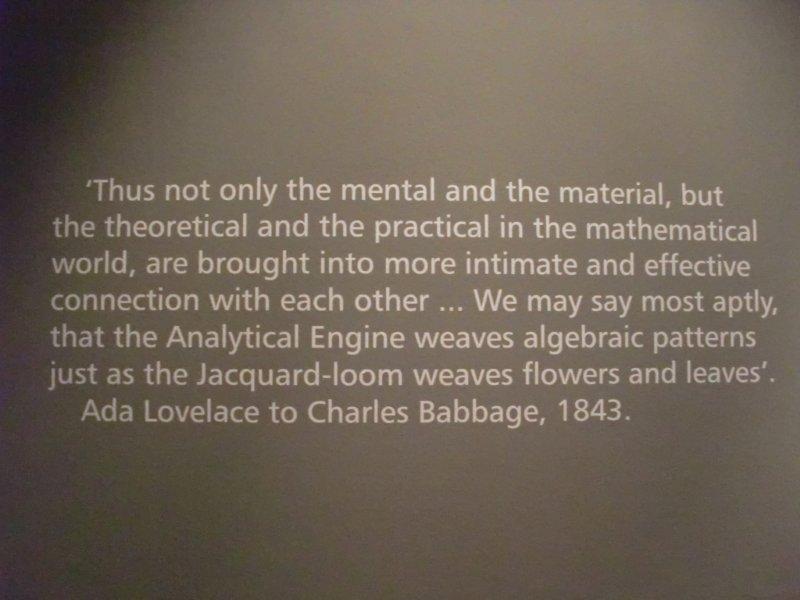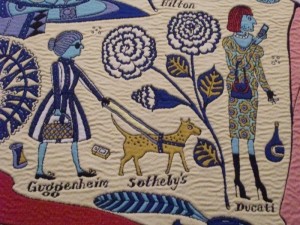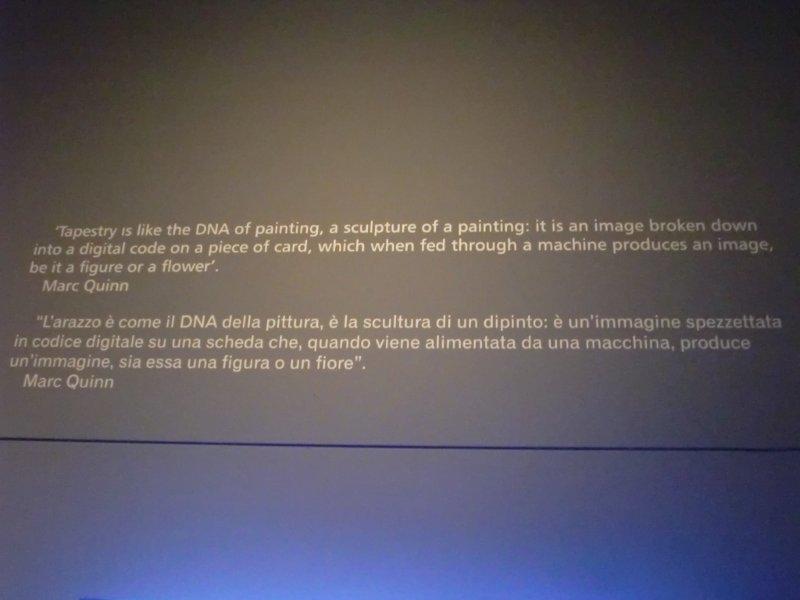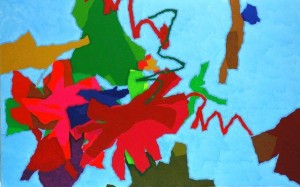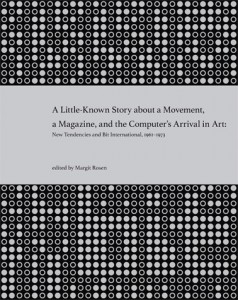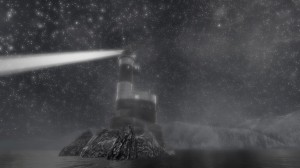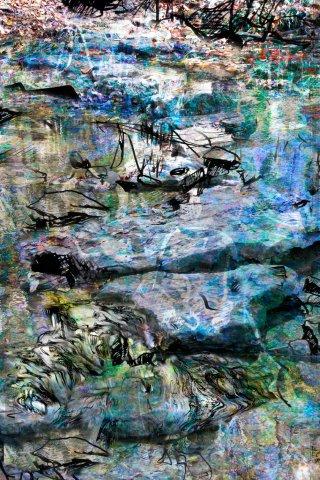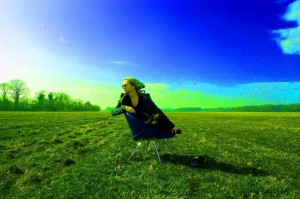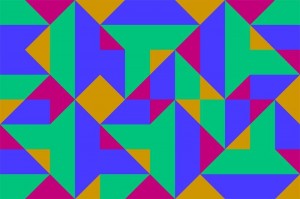Currently on view at Waterman’s in London is this recreation of an imaginary forest by French art duo Scenocosme (Grégory Lasserre & Anaïs met den Ancxt) which aims to turn spectators into apprentice musicians. Read the full article here: http://www.bcs.org/content/conWebDoc/41054
 Catherine Mason
Catherine Mason
Light Constructed by Numbers
This month’s image is a selection of stills from an interactive digital artwork by French artist Anne-Sarah Le Meur, who is interested in questions such as: How does light behave in a virtual space, constructed only by numbers? How do these numbers allow one to play, to disturb, to possibly twist physical laws of light, when one is not looking to simulate realistic phenomena? Read the full text here: http://www.bcs.org/content/conWebDoc/40701
Report from the Venice Biennale
The 54th Venice Biennale (titled ILLUMInations get it?!) is, as to be expected vast but manages to be largely underwhelming, full as it is of found objects, re-positioned, a la Duchamp. However there are some gems to be uncovered spread around the city, if your feet can take the seemingly unending strain.
The prize for Best Artist, rightly in my opinion, went to Christian Marclay for The Clock, 2010 (previously shown in London). The artist has made a composite of film clips that show clocks and watches; he runs these in real time so if it’s 3.30 pm we might see a clip starring, let’s say, Tom Hanks’ acting in a film in which the fictional time is 3.30; a minute later we might see Nicholas Cage (from a different film) looking at his watch and it’s 3.31. The artist must have used literally thousands of clips from old, middling and current movies; some last a few seconds, others maybe a minute. As an artwork it works on several different levels: It is incredibly seductive to watch. And fun to try and spot the films from which his clips are taken. Marclay also manages to run a loose narrative people from several different films clips run up stairs, for example, or it rains for several minutes in a couple different clips. Even people who don’t like art seem to love it. The time involved to produce this, not to mention the skill, is seriously impressive. Can we please have a DVD, so we can watch the entire 24 hours at home?
Here are some more of my highlights:
The Japanese pavilion displays animation by Tabaimo (Ayako Tabata) a young artist inspired by traditional floating world woodblock illustration and contemporary manga imagery. The result is an imaginary city invaded by a creeping sense of unease; at one point a hair-like mass takes over the city a subversion of her inspirations, but a work that still manages a pleasing aesthetic.
At the Guggenheim Collection (the former home of American art dealer-patron Peggy Guggenheim), is a show of New York dealer/curator Ileana Sonnabend. A delicate Sol LeWitt wall drawing joins a host of other exquisite things collected by Sonnabend during the 60s and 70s, all of which have a connection with Venice (where she too had a home). Wonderful to see this historic stuff exhibited in the same city as the cutting-edge Biennale art, but makes me wonder if we’ll pay to see the work of today displayed in 40 years time.
Apart from the official exhibitions, many other Venice museums and institutions mount shows during the months of the Biennale. To my mind one of the most rewarding of these for the art lover is at the Palazzo Fortuny (entitled TRA. Edge of Becoming). Here on view is a wonderful kinetic art work by Davide Boriani (b. 1936) from the early 60s Superficie magnetica. It consist of tiny metal filaments encased in a clear disc, a hidden magnet rotates behind that moves the grey filaments around creating intriguing patterns. This is just the sort of thing, with its connotations of entropy, that pioneering cybernetic artists would have found fascinating.
Here are rooms full of a wide variety of art and objects from a range of periods and locations collected by the Fortuny family over many years which presumably they lived with and loved, displayed to great effect in a palace which is currently under restoration. What makes this such a marvellous place to visit is not only the opportunity to glimpse a collector’s mindset they were clearly attracted to the weird, the surreal, light and optical illusions (including a James Turrell light installation), but also the manner in which diverse objects are put together with much thought and care as to placement and ideas (a whole floor is devoted to the concept of doorways). An interesting comparison can be made with the Francois Pinault collection on view at Ponta Della Dogana at the end of the Grand Canal. Here we have a fabulously wealthy collector who appears to have bought, almost as if from a catalogue, one of each of the most famous and bankable contemporary post-pop artists (Hirst, Charles Ray, Jeff Koons, etc). This is not to do down these artists particularly, nor indeed the beautiful restoration of the former Venice customs house that houses it all, but the collection clearly lacks that idiosyncratic, personal touch of artwork acquired over a lifetime, that tells us of the collector and makes a collection like the Fortuny so memorable.
But the best thing so seen so far at this year’s Biennale is an exhibition entitled Penelope’s Labour: Weaving Words and Images at the Giorgio Cini Foundation on San Giorgio Maggiore (the same island that hosted last Biennale’s wonderful Peter Greenaway digital installation). This thoughtful and beautifully-curated show explains the importance of the Jacquard Loom, especially in relation to contemporary tapestry art. I particularly like the apt quote from Ada Lovelace to Charles Babbage (from 1843), printed up on one wall which arguably marks the beginning of the digital age.
Alongside antique tapestries are displayed works by British artists Marc Quinn and Grayson Perry, whose Walthamstow Tapestry, (following the example of the Bayeux piece) tells an ironic story of 21st Century consumerist life in Britain and is a magnificently witty contribution to contemporary art that deserves to be put on display somewhere permanently. (I hear some of his work is heading for display at the British Museum later this year, maybe this work will make it?) Perry is a consummate draughtsman and this fine work does justice to a skill sadly too often overlooked in avant-garde contemporary art. Here is a blind Guggenheim being led by a guide dog – Sotheby’s:
Autonomous Art Making Machine
Following his recent show in Cork Street, this month’s image is by that great pioneer Harold Cohen, the only artist I know who is tackling the problem of building a program that actually makes art, rather than modelling human art-making. Summer Equinox (below) is representative of the latest development of AARON his art making computer program, and uses paint applied by Harold by hand over underpainting produced by the program. Read the full article here :http://www.bcs.org/content/conWebDoc/40294
Fascinating new book published on an aspect of Computer Art’s history
A Little-Known Story About a Movement, a Magazine, and the Computer’s Arrival in Art: New Tendencies and Bit International, 1961-1973, edited by Margit Rosen has recently been published by MIT Press. I’ve long admired Margit’s work at Germany’s ZKM and this book, clearly the result of years of hard work, brings together Margit’s significant research and curatorial skills. It is a great, weighty tome that delivers a big bang for your buck, illuminating an exhibition movement that took place predominately in Europe – although its reach extended to Britiain and elsewhere (particularily seen in the work of Gustav Metzger, Alan Sutcliffe and others discussed within). Highlights include a clear and useful introductory essay by Margit, re-printed original texts by Metzger, Herbert W Franke, Joanthan Benthall to name just three and numerous photographs and illustrations. The whole publication is wonderfully clear and beautifully laid-out as you might expect from a top-class museum like the ZKM. Well worth a read if you’re interested in questions of why we are where we are today.
A Metaphysical World
May’s image is a still from Ruth Gibson & Bruno Martelli’s, Vermilion Lake, an interactive artwork comprising 3-D computer graphics driven by videogame technology, inspired by the artists travels to the snow-driven mountains of the Canadian Rockies. It is a hauntingly beautiful landscape of forests and reflective water under a big sky full of dazzling stars and snowflakes. Read the full article here: http://www.bcs.org/content/conWebDoc/40012
I am always on the lookout for striking new digital and technologically-mediated images, so please send me your latest works, artists statements, events, etc. for consideration
Digital Imaging: A collaboration with my younger self
Drawing, photography, paint and digital imaging was used to create this gorgeous image by Cynthia Beth Rubin, April’s choice for Image of the Month. Read more about it here:http://www.bcs.org/content/conWebDoc/39534
New Project with Janice Sylvia Brock
I’m thrilled to be working with English-born, Barbadian-resident artist Janice Sylvia Brock to edit her forthcoming book which tells the fascinating and inspiring story of her life. Her paintings are full of the life, colour and warmth of the Caribbean. See more at: http://www.janicesylviabrock.com/
Space Synapse
A talk by artist, designer and entrepreneur Anna Hill, founder of Space Synapse Systems, is scheduled for Thursday 19th May at 6.30pm at Birkbeck, Gordon Square. Space Synapse aims to bring the experiences of Space to the Internet through gaming, virtual edutainment and environmental engineering.
All are welcome at what promises to be a fascinating presentation by this artist who has worked with NASA.
For address and map see: http://www.computer-arts-society.org/
Combating static art
Combating Static Art is this month’s topic for Image of the Month and the chosen artist is Paul Brown with his kinetic painting 4^24.
I am always on the lookout for striking new digital and technologically-mediated images, so please send me your latest works, artists’ statements, events, etc. for consideration.

